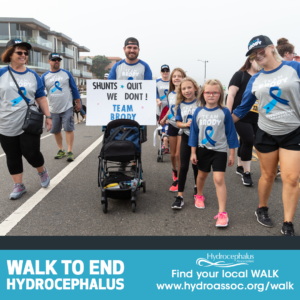Families Across the U.S. Walk to End Hydrocephalus
Walks Raise Funds to Find a Cure for Chronic Brain Disorder 
Today there are over 1 million Americans living with hydrocephalus, a life-threatening neurological condition that has no cure and can only be treated with brain surgery. In September through November, individuals and families impacted by this condition will come together at a WALK to End Hydrocephalus in 44 cities across the country to raise awareness and funds for a cure. The WALKs kick off Hydrocephalus Awareness Month, observed each year in September.
The Hydrocephalus Association (HA) WALKS raise critical funds for HA’s education, support and research efforts. All 44 HA WALKs are 100 percent volunteer-led by dedicated members of the hydrocephalus community.
“For families just learning of a hydrocephalus diagnosis, the future can seem scary and uncertain. By participating in a WALK to End Hydrocephalus, they meet others who understand what they’re going through, learn about resources available to them, and can feel great knowing they are making a real difference in helping the Hydrocephalus Association raise funds for research into a cure and more treatment options,” said Amanda Garzon, National Director of Program Services and Communications.
In 2018, more than 14,000 people participated in a WALK to End Hydrocephalus, raising nearly $2 million for the Hydrocephalus Association’s key research, education and support programs. Jamie Wright, who has participated in the Houston WALK to End Hydrocephalus the past seven years, says the WALK gives her hope for a better future. Jamie developed hydrocephalus as a baby and has endured 15 brain surgeries to manage her condition. She is currently an M.D./Ph.D. student at The University of Texas Graduate School of Biomedical Sciences at Houston, and also volunteers for the Hydrocephalus Association, leading its Houston Hydrocephalus Community Network.
“The Houston WALK to End Hydrocephalus is a great opportunity to meet and connect with others affected by this condition. It is a reminder to me and all those living with hydrocephalus that we are not in this alone,” she explained. “Most of all though, it represents hope. Hope that one day I won’t have to stress about every headache. Hope that one day I will no longer need brain surgery to treat my hydrocephalus. Hope that one day there will be a cure.”
One in every 770 babies develops hydrocephalus, a complex condition marked by excess accumulation of cerebrospinal fluid on the brain. However, anyone at any time can develop hydrocephalus from a brain injury, tumor, or infection, and some people over 60 develop Normal Pressure Hydrocephalus, which is often, misdiagnosed as Alzheimer’s, dementia or Parkinson’s. The primary treatment for hydrocephalus is the insertion of a device called a shunt – a small tube and a connected valve – into the brain to drain the excess cerebrospinal fluid to another part of the body. Shunts save lives, but frequently malfunction, become infected, or blocked. It is not uncommon for a person with hydrocephalus to have ten or more shunt-related brain surgeries throughout their lifetime, and some individuals will undergo more than 100 surgical procedures.
National sponsors for the Hydrocephalus Association WALK program are Medtronic, Aesculap, Codman, an Integra Lifesciences Company, and Mid-Atlantic Permanente Medical Group. To find a WALK to End Hydrocephalus near you, visit: www.hydroassoc.org/walk.
About the Hydrocephalus Association
Founded in 1983 by the parents of children with hydrocephalus, the Hydrocephalus Association (HA) is the nation’s largest and most widely respected organization dedicated to hydrocephalus. More than 60 percent of HA’s funding comes from individual donations, and approximately 35 percent comes from foundation and corporate grants. Since 2009, HA has invested over $12 million in cutting-edge research, making it the largest non-profit, non-governmental funder of hydrocephalus research in the United States. The Hydrocephalus Association’s mission is to find a cure for hydrocephalus and improve the lives of those affected by the condition.
